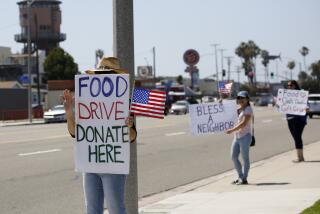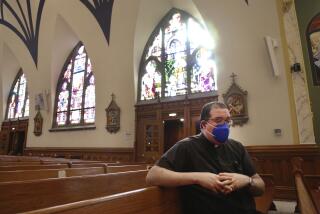Falling Far Short of a Tithe
- Share via
When the offering plate is passed, America’s churches are collecting more dollars than ever, but a new study has found a disturbing trend.
While real-dollar growth over the past 30 years has been impressive, churchgoers are tightening their purse strings.
Measured as a percentage of disposable income, both mainline Protestants and evangelicals gave less in 1998 than they did in 1968. The picture was even grimmer for 10 mainline Protestant denominations and the Southern Baptist Convention, which were examined in more detail. Their percentage of giving in 1998 was lower than it had been even in 1933 during the darkest days of the Depression.
Equally disturbing, most of the money churches are raising is being spent on salaries, in-house programs and building maintenance. The percentage left over for programs for those on the outside--such as soup kitchens, evangelism and missions--is shrinking by the year.
“Leadership in the church is committed to institutional maintenance and is abandoning church members to an agenda of a consumer lifestyle. Leaders are not helping members integrate their faith with their money,” according to Sylvia Ronsvalle, who co-wrote the study with her husband, John L. Ronsvalle. “As a consequence, the church is being perceived increasingly as irrelevant,” she said.
The report warned that if the trend continues, congregations will be spending “little to nothing on others by the middle of this century.”
“The State of Church Giving Through 1998” tracked a composite group of 30 mainline Protestant and evangelical denominations with 29.3 million members representing 100,000 U.S. congregations out of a total 350,000. It was published by empty tomb inc., a Champaign, Ill., research group.
The amount of giving looks good on the surface, the report found. The denominations received $17.2 billion in contributions in 1998, compared with $2.7 billion in 1968. Stated in terms of 1996 dollars to adjust for inflation, the numbers are equivalent to an increase from $10.2 billion to $16.7 billion.
But that increase has not kept pace with the increasing incomes of congregants. On average, churchgoers were giving just 2.52% of their after-tax income to churches in 1998, compared with 3.10% in 1968. Either way, that is a far cry from the biblical standard of giving a tithe--10%.
For the 10 mainline Protestant denominations that were examined more closely, the 2.52% percentage for giving marked a 31-year low. The 10 are American Baptist Churches, the Christian Church (Disciples of Christ), Church of the Brethren, Episcopal Church, Evangelical Lutheran Church in America, Moravian Church in America, Presbyterian Church (U.S.A.), Reformed Church in America, United Church of Christ and the United Methodist Church. The Southern Baptist Convention is not considered by the authors to be a mainline Protestant body, but it was also examined closely.
Findings Support Informal Conclusions
Southern California clergy members said this week that the findings reflect many of their own conclusions, although most were not able to cite numbers to make their case.
“A lot of money goes for keeping the doors open,” said Jetty Fong, administrator at Evergreen Baptist Church of Los Angeles in Rosemead. But she said the 300-member congregation, with an annual budget of less than $1 million, still supports an orphanage in Japan, a hospital in Haiti and outreach efforts in Mexico and China.
At Hollywood First United Methodist Church, the $480,000 annual budget is raised largely by renting buildings to an elementary school and a theater group. Members contribute $120,000.
“People’s incomes are going up, but I think they’re spending money in lots of other ways as well,” said the Rev. Edward Hansen, senior pastor. “The percentage of their income giving doesn’t look like it’s going up.
“In times of national emergency or crisis, people become more aware of their priorities, and sometimes even though financial things are more difficult, their giving proportionately might be actually more,” Hansen said. “When things are going very well, I think we let our priorities slide a bit and maybe we are more focused in enjoying life, going to movies, or dinner at the restaurant or purchasing items we’ve postponed purchasing.”
Churches are used to tapping very wealthy individuals in their congregations, the report said. But they are less comfortable asking the relatively well-off middle class.
“Americans live a fantasy of enjoying great wealth while denying the reality,” the authors wrote. “Consumer debt is a choice, similar to investments. Having money tied up in credit cards, or in the stock market, does not change the fact that a person has resources; these commitments only describe how that person has chosen to spend them.”
They noted that although Americans tend to look to big names like Bill Gates, the founder of Microsoft, to define wealth, “rich” is a relative term. Almost half the world’s population lives on less than $2 a day, they said, quoting a World Bank report for 2000-2001.
In some cases, however, it is the less well-off who give greater proportions of their incomes to churches--a phenomenon that recalls the New Testament story of the poor widow who gave all she had--two small copper coins.
“Giving to charitable causes in general and religious causes in particular is inversely proportional to income,” said the Rev. David Wheeler, senior pastor of First Baptist Church of Los Angeles.
Wheeler said he is finding that to be the case at his downtown congregation, where the demographics have been changing to include more members of ethnic minorities.
The report said that if U.S. church members had been giving an average of 10% of after-tax income in 1998, another $131 billion would have flowed into church coffers to meet the needs of the poor. Those funds would go far in a world where 30,000 children die each day, many from conditions that would cost relatively little to correct, the authors noted.
Various Approaches in Raising Funds
Churches use different approaches to raise funds. All Saints Episcopal Church in Pasadena has a very sophisticated and media-savvy campaign to encourage its membership to increase pledges each year. The pledge card includes a box to be checked if the giver wishes the church to know that the pledge represents 10%--a tithe.
But Evergreen Baptist Church has no fund-raising drive of any kind. “We try to educate our congregation about stewardship, but don’t have direct appeals. We don’t have annual pledge drives. . . . Everyone gives what we call sacrificially, and they give from their resources and their heart. We just pray a lot and trust our budget is going to be met,” Fong said.
Church members usually do not like to talk about money, and many pastors are poorly equipped to push the issue, the report said.
That, of course, is not the case for some denominations. The Church of Jesus Christ of Latter-day Saints, for example, expects members to contribute a full 10% of their incomes, barring mitigating circumstances.
Each year, members meet with their local bishop and are asked if their contributions represent full tithes, according to Los Angeles stake President Michael J. Fairclough. If a member says no, the bishop asks if the family would like to increase its giving. If members can’t, the issue isn’t pushed.
But, failure to pay a full tithe, unless there are mitigating circumstances, could result in a member’s being barred from the temple, where rituals central to the Mormon faith are conducted.
“I’ve seen no sign of any slowdown in giving,” Fairclough said. “It’s a 10% commandment as far as we’re concerned, and the faithful members of the church continue to pay it.” In addition, he said Latter-day Saints give “fast offerings” each month specifically earmarked for helping the poor, regardless of faith.
(BEGIN TEXT OF INFOBOX / INFOGRAPHIC)
Highlights of the Report
* Per-member giving increased from $367.79 to $569.81 in inflation-adjusted dollars, an increase of 55% from 1968 to 1998.
* U.S. per capita disposable (after-tax) income increased 91% in inflation-adjusted dollars, from $11,864 in 1968 to $22,637 in 1998.
* Per-member giving as a percentage of income declined from 3.10% in 1968 to 2.52% in 1998, a decline of 19%.
Source: The State of Church Giving Through 1998
More to Read
Sign up for Essential California
The most important California stories and recommendations in your inbox every morning.
You may occasionally receive promotional content from the Los Angeles Times.













